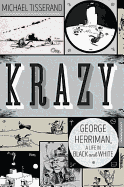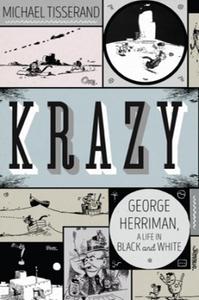
 If ever there was a cult comic strip, George Herriman's Krazy Kat was probably it. Born at the dawn of the 20th century and for 30 years a syndicated feature of major U.S. newspapers, it was revered by artists and intellectuals like T.S. Eliot, E.E. Cummings, Dr. Seuss, Carl Sandburg, P.G. Wodehouse, Langston Hughes and Woodrow Wilson. Intrigued by Herriman's Tremé roots, New Orleans writer and former editor of its alternative newspaper Gambit Weekly Michael Tisserand (The Kingdom of Zydeco) immersed himself in Herriman's broad comic archive and with painstaking research uncovered the rich details about the man novelist Michael Chabon calls "one of the very great artists in any medium of the 20th century." An encyclopedic biography illustrated with many examples of Herriman's work, Krazy is also a captivating history and critique of newspaper comic strips and the artists who created them.
If ever there was a cult comic strip, George Herriman's Krazy Kat was probably it. Born at the dawn of the 20th century and for 30 years a syndicated feature of major U.S. newspapers, it was revered by artists and intellectuals like T.S. Eliot, E.E. Cummings, Dr. Seuss, Carl Sandburg, P.G. Wodehouse, Langston Hughes and Woodrow Wilson. Intrigued by Herriman's Tremé roots, New Orleans writer and former editor of its alternative newspaper Gambit Weekly Michael Tisserand (The Kingdom of Zydeco) immersed himself in Herriman's broad comic archive and with painstaking research uncovered the rich details about the man novelist Michael Chabon calls "one of the very great artists in any medium of the 20th century." An encyclopedic biography illustrated with many examples of Herriman's work, Krazy is also a captivating history and critique of newspaper comic strips and the artists who created them.
The child of French-speaking mixed race Creoles, Herriman was sufficiently light-skinned to "pass" his whole life as a white man claiming to be the son of French immigrants; he was often called by colleagues "George the Greek" because of his kinky hair and swarthy complexion. Raised in Los Angeles from age 10, he attended Catholic high school before applying his drawing skill and quirky humor to newspaper illustration and cartoons. He learned English in the streets of New Orleans; Latin and German at school; and became articulate in Spanish and Navajo during his later years in Arizona. Herriman launched several syndicated comic strip characters with Joycean names like Pinky Doolittle, Punky Pheetes and Pedesy Fuzzyplace after cutting his cartoon teeth illustrating sports and political events for the New York Evening Journal. When he picked the character Krazy Kat from his Dingbat Family strip to feature in its own comic, he found the perfect vehicle for his skewed humor. Krazy Kat, Ignatz Mouse and Officer Pupp not only tickled the whole country's funny bone, they also won the lucrative loyalty of William Randolph Hearst.
A multilingual combination of vaudeville pratfalls and violence, minstrel show imitation, the optimism and good-heartedness of Chaplin's Tramp, and the Beckettian dialogue of Vladimir and Estragon, Krazy Kat was a precursor of the chaos and upheaval of the 20th century. An example from April of 1921 says it all:
IGNATZ: Now, "Krazy," do you look upon the future as a pessimist, or an optimist?
KRAZY KAT: I look upon it as just mist--
Herriman's vision, sketches and dialogue influenced the epochal comic strips of Charles M. Schulz and Garry Trudeau. With substantial background fieldwork, Tisserand eloquently demonstrates that this self-effacing, mixed-race high school graduate from the streets of the Tremé, laboring for 40 years over a schedule of daily cartoons, became the inspiration of a century of artists, intellectuals, filmmakers and writers. --Bruce Jacobs, founding partner Watermark Books & Cafe, Wichita, Kan.
Shelf Talker: Rich in original research, New Orleans writer Tisserand's encyclopedic biography of Krazy Kat artist George Herriman is also an enlightening history of modern comics strips.

